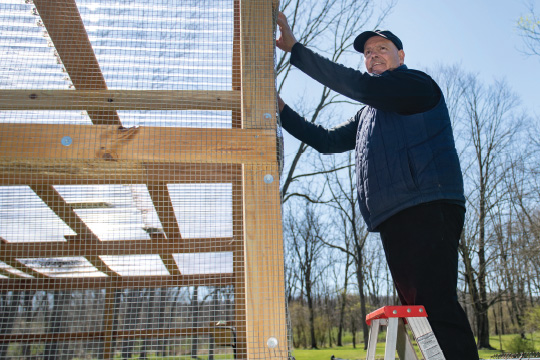Unfortunately, it doesn’t matter how hard you try, heredity is heredity, says Sutton, 58, of Independence Township.
A major procedure leads to an outstanding outcome.
Nothing fills Doyle Sutton with energy like a day of weight training and cardio at the gym. He’d always hoped that staying fit could help him prevent a heart attack, a health emergency that claimed the lives of his mom and two of his sisters.
“Unfortunately, it doesn’t matter how hard you try, heredity is heredity,” says Sutton, 58, of Independence Township.
His heart troubles began early last year, when he couldn’t maintain his usual high level of activity. “I’d go to the gym, work in the yard and I’d notice it was a little harder to breathe,” he says. “I thought I was overdoing it, that I was maybe too old to work like this.”
Concerned, Sutton visited his primary care physician, who diagnosed a heart murmur and referred him to cardiologist Darshan Godkar, MD, Medical Director, Radial Program, at Cooperman Barnabas Medical Center (CBMC).
Searching for a Cause
Among the tests the cardiologist ordered was a CT scan of the heart to measure the amount of calcium buildup in the arteries. A score between 100 and 300 means a moderate amount of calcium is present. A score higher than 300 indicates severe coronary artery disease (CAD), which is narrowing or blockage of the major blood vessels that supply the heart. It also indicates high risk for a heart attack.
“My score was something like 1,000,” Sutton says. “Dr. Godkar said he almost fell off his chair when he saw it.”
Dr. Godkar referred Sutton to Arash Salemi, MD, Clinical Chairman of Cardiothoracic Surgery at RWJBarnabas Health, Professor of Surgery at Rutgers New Jersey Medical School and a member of RWJBarnabas Health Medical Group. Dr. Salemi ran additional tests that found Sutton also had aortic stenosis, a narrowing of the aortic valve.
“The aortic valve acts as a doorway that sits between the heart and the rest of the body,” Dr. Salemi says. The opening should be as wide as a silver dollar, he explains, but Sutton’s was smaller than a dime. “That meant that when he exerted himself, his heart would pump fine—his heart muscle was as strong as a marathon runner’s—but his narrowed valve restricted the amount of blood pumping through his body,” he says.
More testing revealed that a tight blockage had formed in his left main coronary artery. “Upwards of 75 percent of patients with severe aortic stenosis like Doyle’s have some degree of blockage in their coronary arteries,” Dr. Salemi says.
Open Heart Surgery
“Dr. Salemi put my mind at ease when I talked with him,” Sutton says. “He’s super nice.” But he still wasn’t sure he wanted to go through with Dr. Salemi’s proposed treatment—open heart surgery. “Thankfully, my wife, Sharon, pushed me to do it,” Sutton says.
On February 10, Dr. Salemi performed the surgery at CBMC, replacing Sutton’s faulty valve with a new valve made from bovine (cow) tissue. He also performed two bypasses around Sutton’s blocked arteries to restore his coronary blood flow. Five days later, Sutton was back home.
Sutton then completed a full course of cardiac rehabilitation, slowly increasing his exercise tolerance to strengthen his heart.
In addition, he stayed active on his own. “I have a two-acre property, and I was raking leaves and pushing my mower just a few weeks after surgery,” he says. “I did it in little steps over a number of days.”
Today, he’s ready to go back to the gym and return to his job as a shipping and receiving lead for a specialty chemical company. “Doyle had a great attitude both pre-op and post-op,” Dr. Salemi says. “He’s got a new engine. He can get out there and do anything he wants.”
On his road to recovery, Sutton is sharing a potentially lifesaving message with his friends and co-workers. “I recommend people get their physicals and a full cardio workup,” he says. “It’s the best way to know if something is wrong with your heart so you can get it fixed.”

Treatment Options For Coronary Artery Disease
Coronary artery disease (CAD) is usually caused by plaque buildup that makes arteries narrow over time.
- For moderate CAD, doctors may prescribe medical therapy, including statin drugs to reduce levels of low-density lipoprotein (LDL, or “bad”) cholesterol, and aspirin to help thin the blood and improve blood flow.
- For CAD causing one or two blockages, percutaneous coronary intervention (PCI), a minimally invasive approach, may be recommended. A doctor will use a catheter (a thin tube) to place a stent (a small mesh tube). “A stent pushes plaque out of the way and restores blood flow,” says Arash Salemi, MD, Clinical Chairman of Cardiothoracic Surgery at RWJBarnabas Health.
- For CAD that involves multiple blocked vessels or blocked vessels in higher-risk areas of the heart, open heart surgery, in which the chest wall and sternum are cut to provide access to the heart, may be recommended.
While open heart surgery is the most invasive treatment option, it’s also very effective. “The operation has been perfected over time,” says Dr. Salemi, “so we routinely get outstanding outcomes even with the most complex of surgeries.”
Whoever your heart beats for, our hearts beat for you. Connect with a top cardiovascular expert at Cooperman Barnabas Medical Center.